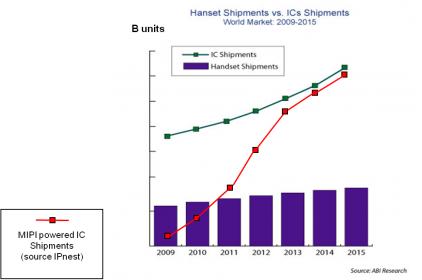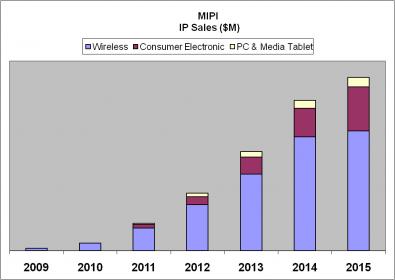According with the MIPI Alliance, the year 2009 has been the time for MIPI specification to be developed, when 2010 was dedicated to Marketing and Communication effort to popularize MIPI technologies within the SC industry, finally the year 2011 is expected to see MIPI deployment in the mass market, at least in the Wireless (Handset) segment.
MIPI is an Interconnect protocol offering several key advantages: strong modularity allowing minimizing power but also reaching high bandwidth when necessary (6 Gbps, 12 Gbps…), interoperability between IC coming from different sources: Camera Controllers (CMOS Image Sensor), Display Controller, RF Modem, Audio Codec and an Application Processor. It take advantage of the massive move from parallel to serial interconnect we have seen, illustrated by PCI Express replacing PCI, SATA replacing PATA etc… to use similar technologies in Mobile Devices, where low power is key, as well as the needs for higher and higher bandwidth.
Even if MIPI as an IP market is still at the infant stage, we expect it to strongly grow in 2011, at least in the wireless handset segment. We have started to build a forecast for MIPI powered IC in production, for 2010-2015.

The number of IC in production is a key factor to push for MIPI adoption as a technology: test issues have been solved, no impact on the yield and, last but not least, IC pricing going down, benefiting from the huge production quantities (almost 1Billion IC in 2010) generated by the wireless handset segment.This is true for the Application processor (OMAP5 and OMAP4 from TI, Tegra 2 from NVIDIA, U9500 from ST-Ericsson…) which can be reused for other Mobile Electronic Devices and also for the peripheral ASSP supporting Camera, Display, Audio Codec or Modem applications. These MIPI powered price optimized ASSP can be also used in segments like PC (Media Tablet) and for Mobile Devices in CE.
The Tier 2 chip makers, playing in the wireless segment could minimize their investment in this new technology (need for an AMS design team) and gain TTM by externally sourcing MIPI IP if they want to enter into the lucrative high end segment (Smartphone), which grew by 71% in 2010. For the same reason, MIPI pervasion in the above mentioned new segments would then be eased by the availability of these ASSP and by off the shelf MIPI IP. Finally, the pervasion of MIPI should also occur in the mid range wireless handset (feature phones). The overall result for 2010-2015 IP sales forecast is shown here:

Take a look at “MIPI IP survey” from IPnest
See:http://www.ip-nest.com/index.php?page=MIPI
it gives information about:
MIPI powered IC Forecast 2010-2015
IP Market Analysis: IP vendor competitive analysis, market trends
MIPI IP 2010-2015 Forecast by Market segment:
– Wireless Handset
– Portable systems in Consumer Electronics
– PC Notebook & Netbook, Media Tablets
License price on the open market for D-PHY & M-PHY IP, by technology node
Penetration rate by segment for 2010-2015 of MIPI PHY and Controller IP?
ASIC/ASSP world wide designs start, and related IP sales from 2010 to 2015?
From Eric Esteve
eric.esteve@ip-nest.com
(**) MIPI is a bi-directional high speed serial differential signaling protocol, power consumption optimized and dedicated to the Mobile Devices, to be used to Interface chips within the system, at the board level. It uses a Controller (digital) and a mixed signal PHY. There are numerous specifications (DSI, CSI, DigRF, LLI…), but all of these rely on one of the two PHY specifications (D-PHY and M-PHY). M-PHY supports different modes of operation:
- LP at frequency range of 10K-600Mb/s
- HS at frequency range of 1.25 to 6 Gb/s
The protocol is scalable, so you can implement one or more lanes in each direction.See:http://www.mipi.org/momentum
Share this post via:






Quantum Computing Technologies and Challenges